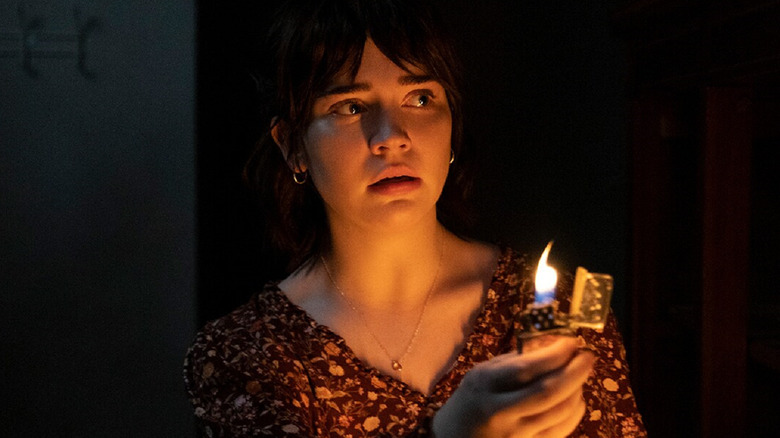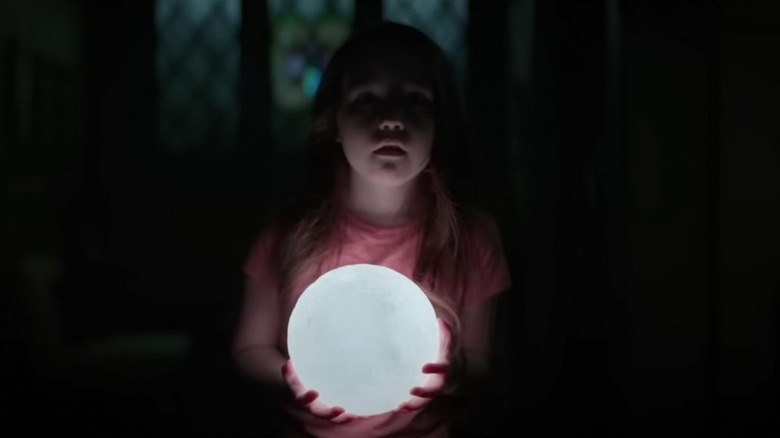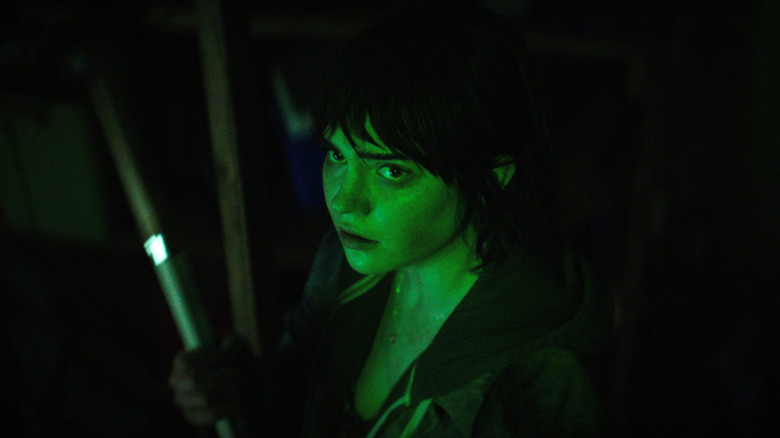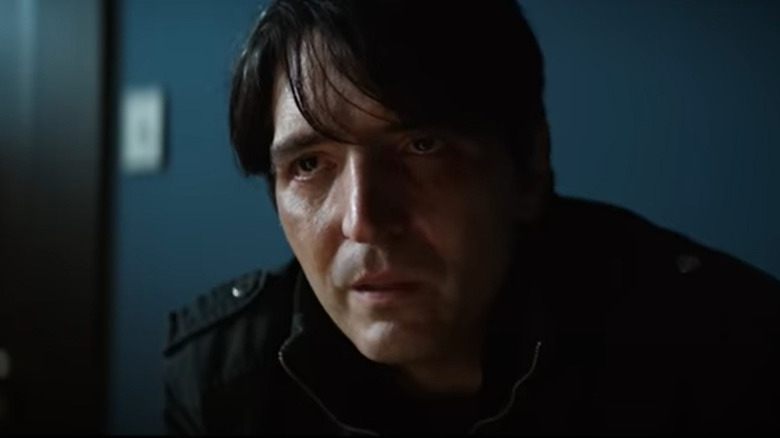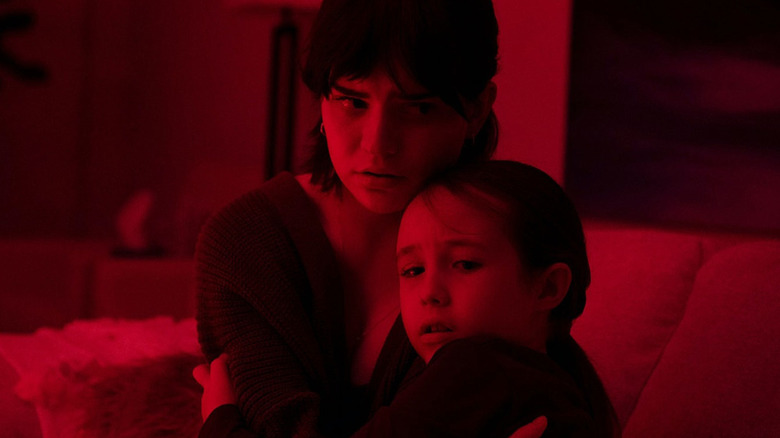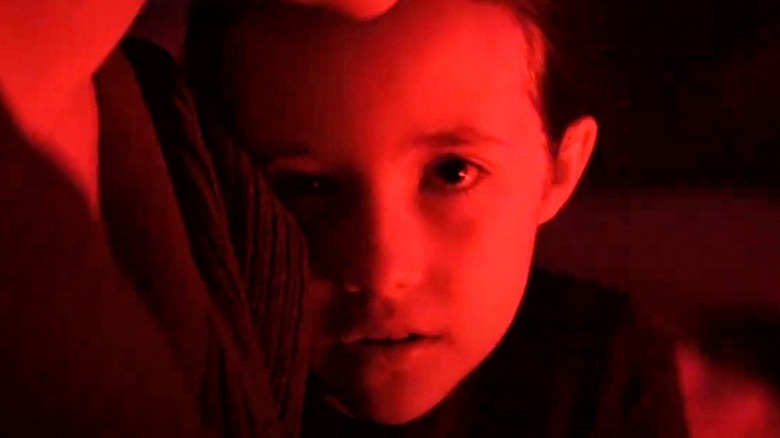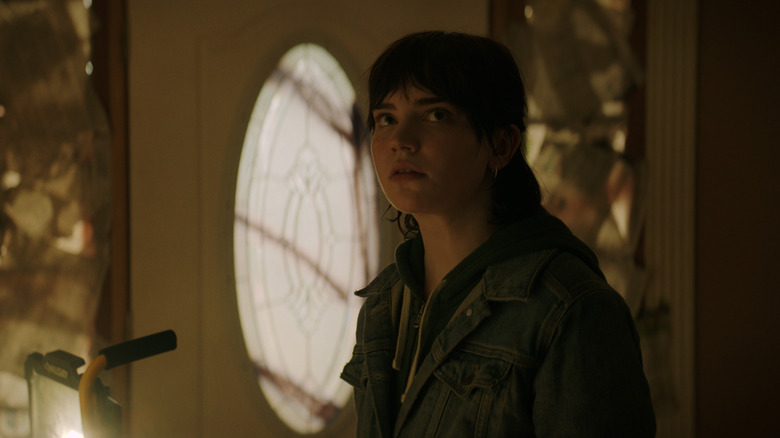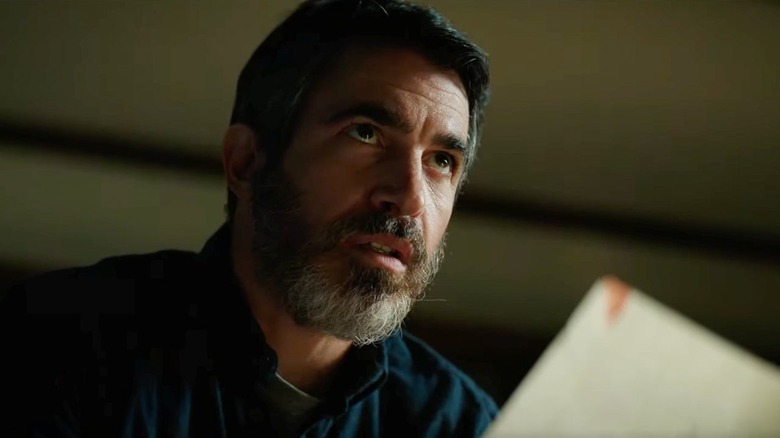The Ending Of The Boogeyman Explained
Director Rob Savage took the bare bones of a 1973 short story by Stephen King and further developed the lore around its titular monster. In that brief tale, the Boogeyman is only spoken about and glimpsed briefly at the end. Here, merely mentioning its name and the way it feeds on the grief of others brings it into a household still mourning a devastating recent loss — and once it arrives in someone's life, it's not letting go easily. As you might be able to guess, the Boogeyman makes regular appearances — not just a cameo at the end — in this version of King's tale.
Transformed into a more traditional ghost story than its source material, Savage's film is one of several recent horror efforts that explores the mental devastation caused by grief through an otherworldly curse, joining the likes of "Smile" with its sinister, otherworldly allegory. Because of this, there's much to unpack, so let's get into it.
What you need to remember about the plot of The Boogeyman
Returning to work shortly after the death of his wife, Will Harper (Chris Messina) is visited by new patient Lester Billings (David Dastmalchian). Billings tells him, in a sequence that's the basis of King's short story and has been lifted faithfully here, that all three of his children died at the hands of a mythical monster known as the Boogeyman. He blames himself for not noticing "the thing that comes for your kids when you're not paying attention." The short story ends with the twist that the therapist is the Boogeyman in disguise returning to haunt Lester, but that's not the case here.
As Will goes next door to make a call to the authorities about a patient he sees as disturbed, Lester is heard whimpering around the house at what sounds like the Boogeyman. After teenage daughter Sadie (Sophie Thatcher) hears this, she goes looking, and finds Lester's body. Lester's death — an apparent suicide — appears to transfer the curse to the Harper household, as youngest daughter Sawyer (Vivien Lyra Blair) begins seeing the monster under her bed, which the other family members initially write off as a product of her fear of the dark.
Eventually, Sadie starts seeing the beast her sister is afraid of, and through research into Lester Billings, tracks down his family home. While looking around, she discovers that his wife Rita (Marin Ireland) is very much still living there and is singularly dedicated to killing the Boogeyman for revenge. After an elaborately staged ruse to lure it out of the shadows — light hurts the Boogeyman, it seems — she attempts to kill it. But even though the Boogeyman can be hurt, it recovers easily, and soon disappears back across town into the darkness to haunt the Harpers.
If you or anyone you know is having suicidal thoughts, please call the National Suicide Prevention Lifeline by dialing 988 or by calling 1-800-273-TALK (8255).
What happened at the end of The Boogeyman?
After his daughters spend much of the film trying to convince him that there really is an evil force coming for them, Will finds himself going head-to-head with the Boogeyman. After leaving Rita's house following the failed attack on the Boogeyman, Sadie hurriedly calls her father and warns him of what's coming, but Sawyer has already seen it in the shadows of their home while he wasn't paying attention. Before Will knows it, he's been dragged into the basement.
When Sadie arrives, she rushes down and finds herself taken captive by the monster almost immediately; it opens its jaw to reveal a separate body crawling out to quite literally feed on grief. However, because she understands that its biggest weakness is light, Sadie takes down the Boogeyman via some crafty thinking. The lighter that once belonged to Sadie and Sawyer's mom, which Sadie uses to smoke pot earlier in the movie, is used as a flamethrower. Gasoline is poured on the floor, and the Boogeyman burns up along with the house and the dark mold which has covered the ceiling and the walls since it showed up.
In the final scene, the family returns to therapy and openly discusses their fears of losing each other, concluding that they can finally adapt to life without their mom around. But as they walk out, Sadie is called back in by the therapist who isn't there; she only sees the closet door ajar and sounds coming from inside. Rather than investigate it, she decides that's enough for one day and closes the door. Cue the ironic use of "Burning Love" by Elvis over the end credits as the family returns to their demolished home.
Is the Boogeyman still with us?
The film's ending, where the Boogeyman is apparently still hiding in a therapist's closet, appears to be an intentional reference to the original short story. There, Lester Billings returns to the therapist's office after he finds there isn't a nurse outside to make a follow-up appointment.
He sees the room is now empty, but the closet door is open "just a crack," with a voice inside repeating the phrase "so nice." As it turns out, the therapist was the Boogeyman wearing a mask the entire time. But the sight of a closet door left ajar in a therapist's office is as far as the similarities between the two scenes go; in the movie, we see that the therapist is not a monstrous entity, and Sadie immediately closes the door, symbolically refusing to let the monster come back out and into her life.
It's a textbook ambiguous horror ending, quite literally closing the door on this story whilst keeping the threat alive in case a sequel ends up getting greenlit. In fact, the monster's apparent continued presence is the only narrative loose end that still needs to be wrapped up, and within the final scene, there are plenty of indications of how it could break loose and return to wreak havoc on the family's lives.
A family's grief
There is only one bit of lore needed to understand this iteration of the monster — it grows stronger on human misery, aiming to cause more tragedy where it's already happened in order to consume more grief. It follows Lester Billings wherever he goes, kills his three children one at a time, and finds itself right at home within a family still struggling to adjust back to normal after a mother's death. The youngest daughter is more frightened of the dark than ever, and the eldest refuses to wear anything but her mother's clothes and breaks down if they get spoiled.
After the apparent defeat of the Boogeyman, we see the family return to counseling in a heartfelt epilogue in which they openly discuss their feelings and finally conclude that they can "do it without mom." It's an ending that suggests they're facing up to the loss and healing in a way that allows them to quite literally lock their demons in a closet but there's an alternative interpretation if you care to look a little closer.
No matter how far removed from grief you are, it's still hard to come to terms with, which is enough to ensure a monster that feeds on those emotions will never be fully banished. You only need to look back at the home of Rita Billings for proof; her grief may have transformed into vengeance against the being that caused it, but those emotions are still underpinned by loss. The Boogeyman can get weaker, but never fully exorcized in a home after heartbreak.
The significance of the lighter
One of the crucial parts of the family's healing process comes via the way the Boogeyman is defeated, even if it eventually reveals itself to be only temporarily vanquished. Earlier in the film, as Sadie attempts to bond with high school friends she's drifted apart from, they all decide to smoke weed and use her mother's lighter to blaze up. This memento connecting Sadie to her mother seems to portend the Boogeyman's arrival, as the monster soon returns for her.
In the final act, as the family fights back in the basement, the Boogeyman is eventually stopped in its tracks via the mum's lighter, which is used to help create a makeshift flamethrower with some gasoline. On first glance, this appears in-keeping with the pre-established weaknesses of the monster; it can't survive when brought into the light. However, the significance is much stronger if it suggests that a more effective way to destroy the Boogeyman is to directly evoke the memories of those you're grieving, making them an active part of the moment rather than departed souls.
That may sound like a reach but consider what we saw in Rita's house earlier in the movie — we know the Boogeyman can be hurt through brutal acts of violence, but it tends to recover to full power quickly. To truly stop a creature that feeds on grief, you need to weaponize the memories of your lost loved ones, directly confronting your emotional trauma to stop the creature trying to feast on it dead in its tracks.
How else does it compare to the source material?
As the original story takes place entirely within Dr. Harper's office, there are very few similarities between the story and the movie beyond the one scene directly adapted from the source material. Screenwriters Scott Beck, Bryan Woods, and Mark Heyman opted to mostly use the short story as an inciting incident to get the plot rolling.
Additionally, there is a clear difference in characterization between the Lester Billings of the source material and the movie's Lester. He's portrayed as a little shiftier in this newer iteration, roaming around the house and leaving it briefly ambiguous as to whether he'll attack Sadie. The terror in the original short story is not knowing whether you're listening to the irrational account of a murderer or not; meanwhile, the very premise of this film is predicated on him telling the truth. The movie version of Lester is creepier, but to his credit, he doesn't express the homophobic fears underlying his parenting tactics, nor does he display the casual racism present in King's take on this character.
The movie also depicts Rita Billings for the first time, and her characterization is changed considerably from her husband's dubious description in the story. There, Lester speaks of her with contempt for her parenting style that he thinks would've made his children grow up to be "sissies," and tells his therapist how he threatened her with violence for going against his word. The Rita of this movie is similarly wracked by grief, but she isn't a victim — she's motivated by revenge, refusing to leave her four walls until she takes down the monster that claimed her children's lives.
What Rob Savage has said about The Boogeyman
Director Rob Savage has been on the record about how he worked with the small team of screenwriters to completely renovate King's original story into a feature-length script and looked across the author's entire body of work for inspiration.
In an interview with SFX Magazine, he said, "This movie attacks the source material in a way that's different from any other King adaptation. We wanted this to feel true to his writing. Me and [co-screenwriter] Mark Heyman were always going back to the warmth of character that you feel in King's novels. Even when the subject matter is dark, there's that glimmer of hope. He's not a cynical writer."
This quote is the best reflection of what the movie is going for with its ending, showing the family coming together even while the biggest threat against them shows signs of waking once more.
What the cast has said about The Boogeyman
At the recent Los Angeles premiere, the cast were interviewed on the red carpet about the movie, and their comments further reflect how in some of their minds, this is a tale about a family coming together.
Chris Messina told reporters, "I think the director did a great job dealing with grief. This is a family who've been in hard times and they're struggling, but 'The Boogeyman' is exactly what they need, and it brings them together." This comment adds an additional reading to the film's ending — now that they're beginning to heal as a family unit from the loss of their matriarch, they don't need the threat of a monster as glue that can hold them together. That monster can comfortably remain in the closet.
Although this is a story directly about a family, Sophie Thatcher has argued that the monster as a metaphor could be interpreted in multiple other ways, telling a red-carpet reporter, "In any culture, there's some kind of Boogeyman, and it can stand for any kind of anxiety, so you can personalize and internalize it any kind of way. That's why the movie is scary — it's not some specific kind of Victorian ghost; it's the Boogeyman!"
This quote means that even though we've got a handle on the literal interpretation of the ending, fan theories about the movie from around the world will likely shine a deeper light on it. We look forward to diving into those once more people have had a chance to see the movie.
What the ending of The Boogeyman could mean for a potential franchise
As we can tell from the ending, the door is metaphorically left open — even if it's literally closed — for a sequel if this movie turns out to be a box office hit. With several original horror movies delivering lucrative performances recently, it would be foolish to bet against that happening, and the direction for a sequel is clearly laid out in that final scene — a family fully comes to terms with their grief but struggles to keep the Boogeyman from returning to their lives.
With no mid- or post-credits sequences to speak of, there are no further clues as to how King's world would be expanded beyond this in a potential sequel. However, there is one other crucial factor which determines whether we'll get another film, should this be a success — the fact that Stephen King absolutely loves this movie.
Speaking at the recent Los Angeles premiere, Savage said, "He (King) apparently had the best time, it scared the s**t out of him. He sent me this lovely essay (after) about how much he'd enjoyed the movie. To have made a movie that scared Stephen King, that's a 'pinch me' moment."
So, with the legendary author on board as a fan of Savage's film, don't rule out his return if a sequel ever enters development.
